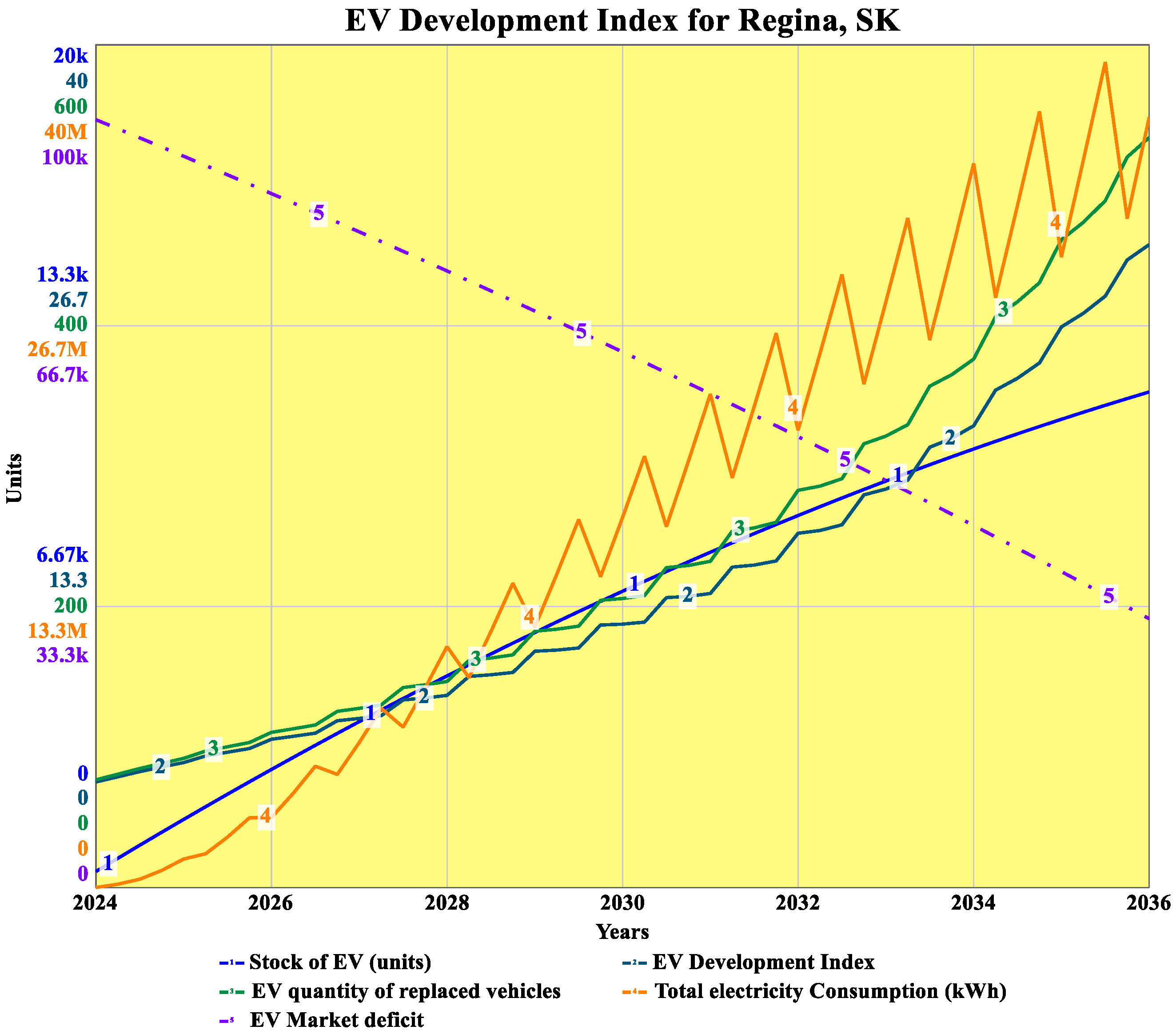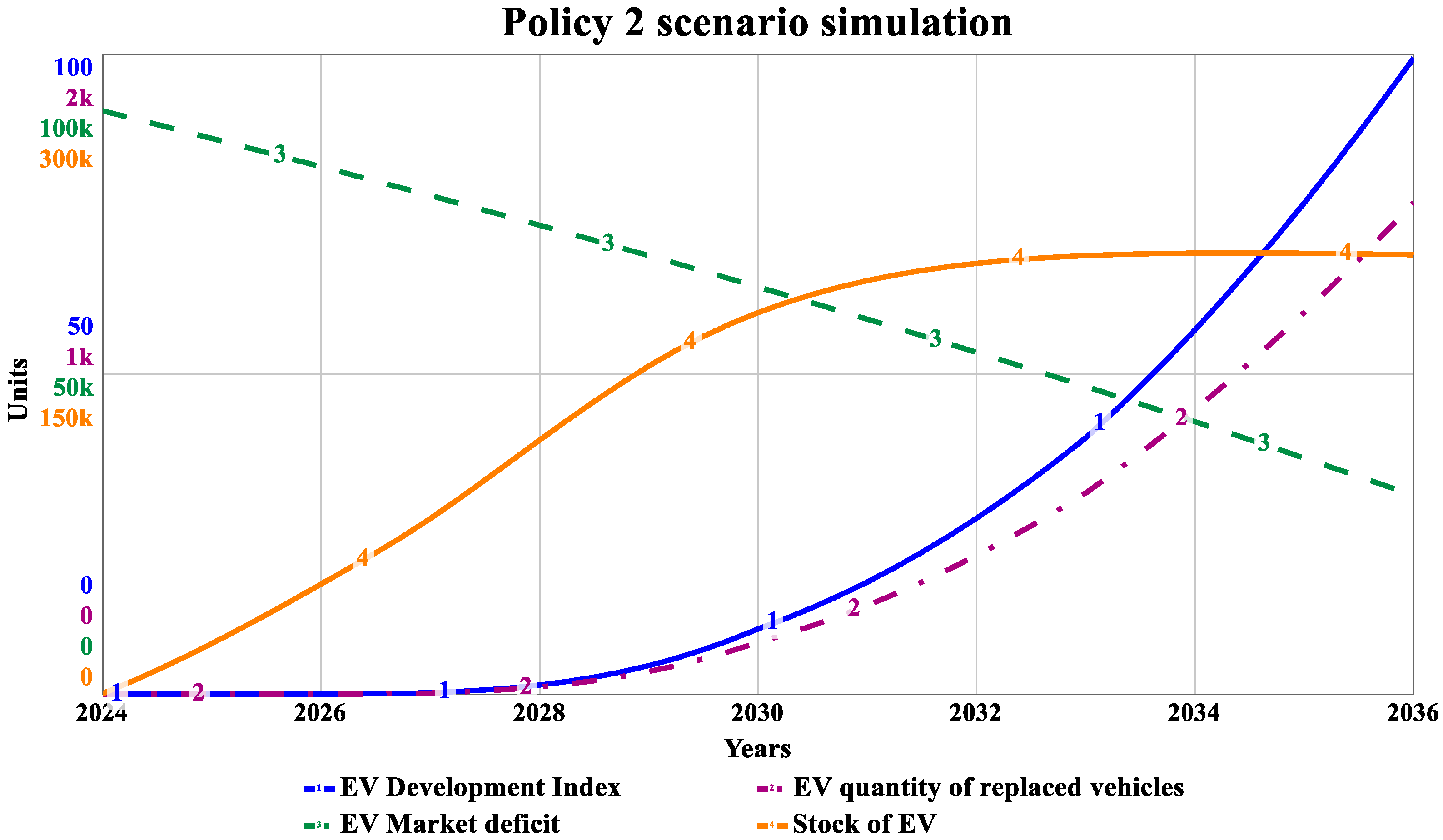Forecasting Electric Vehicle Adaption Using System Dynamics: A Case Study of Regina, Saskatchewan †
Abstract
1. Introduction
2. Materials and Methodology
2.1. Study Area and Data Source
2.2. Dynamically Hypothesized Causal Loop Diagram
2.3. Stock-Flow Diagram
3. Baseline Simulation Results and Discussion
4. Model Validation and Policy Simulation
5. Conclusions
Author Contributions
Funding
Institutional Review Board Statement
Informed Consent Statement
Data Availability Statement
Conflicts of Interest
References
- Environment and Climate Change Canada. Canadian environmental sustainability indicators: Greenhouse gas emissions. 2024. Available online: https://www.canada.ca/en/environment-climate-change/services/environmental-indicators/greenhouse-gas-emissions.html (accessed on 7 June 2024).
- Macdonald-Laurier Institute. A Bumpy Road Ahead: A critical assessment of Canada’s Electric Vehicle Availability Standard. 2024. Available online: https://macdonaldlaurier.ca/a-bumpy-road-ahead-a-critical-assessment-of-canadas-electric-vehicle-availability-standard-jerome-gessaroli/ (accessed on 7 June 2024).
- Environment and Climate Change Canada. 2023 Progress Report on the 2030 Emissions Reduction Plan; Environment and Climate Change Canada: Burlington, ON, Canada, 2023.
- Anderson, N. City of Regina’s 2023-24 General and Utility Fund Operating Budget and 2023–2027 Capital Budget. 2022. Available online: https://www.regina.ca/export/sites/Regina.ca/city-government/budget-finance/.galleries/pdfs/2023-24-Budget-Book-Proposed.pdf (accessed on 16 June 2024).
- City of Regina. Energy & Sustainability Framework Energy & Emissions Reduction Action Plan; City of Regina: Regina, SK, Canada, 2022. [Google Scholar]
- Statistics Canada. New Motor Vehicle Registrations, Quarterly; Statistics Canada: Regina, SK, Canada, 2024.
- Verma, A.; Raj, R.; Kumar, M.; Ghandehariun, S.; Kumar, A. Assessment of renewable energy technologies for charging electric vehicles in Canada. Energy 2015, 86, 548–559. [Google Scholar] [CrossRef]
- Domarchi, C.; Cherchi, E. Electric vehicle forecasts: A review of models and methods including diffusion and substitution effects. Transp. Rev. 2023, 43, 1118–1143. [Google Scholar] [CrossRef]
- Coffman, M.; Bernstein, P.; Wee, S. Electric vehicles revisited: A review of factors that affect adoption. Transp. Rev. 2016, 37, 79–93. [Google Scholar] [CrossRef]
- Kumar, R.R.; Alok, K. Adoption of electric vehicle: A literature review and prospects for sustainability. J. Clean. Prod. 2020, 253, 119911. [Google Scholar] [CrossRef]
- Vahidmohammadi, A. A Comparative Study of Short-Term Electric Vehicle Load Forecasting Using Data-Driven Multivariate Probabilistic DeepAR Approach; The University of Regina: Regina, SK, Canada, 2021. [Google Scholar]
- Adedeji, B.P.; Kabir, G. A feedforward deep neural network for predicting the state-of-charge of lithium-ion battery in electric vehicles. Decis. Anal. J. 2023, 8, 100255. [Google Scholar] [CrossRef]
- Afandizadeh, S.; Sharifi, D.; Kalantari, N.; Mirzahossein, H. Using machine learning methods to predict electric vehicles penetration in the automotive market. Sci. Rep. 2023, 13, 8345. [Google Scholar] [CrossRef] [PubMed]
- Xiang, Y.; Zhou, H.; Yang, W.; Liu, J.; Niu, Y.; Guo, J. Scale Evolution of Electric Vehicles: A System Dynamics Approach. IEEE Access 2017, 5, 8859–8868. [Google Scholar] [CrossRef]
- Vilchez, J.J.G.; Jochem, P.; Fichtner, W. EV Market Development Pathways – An Application of System Dynamics for Policy Simulation. In Proceedings of the EVS27 International Battery, Hybrid and Fuel Cell Electric Vehicle Symposium; Barcelona, Spain, 17–20 November 2013, pp. 1030–1038.
- Saraf, N.; Shastri, Y. System dynamics-based assessment of novel transport options adoption in India. Clean Technol. Environ. Policy 2022, 25, 799–823. [Google Scholar] [CrossRef] [PubMed]
- Keith, D.R.; Struben, J.J.; Naumov, S. The Diffusion of Alternative Fuel Vehicles: A Generalised Model and Future Research Agenda. J. Simul. 2020, 14, 260–277. [Google Scholar] [CrossRef]
- Statistics Canada. Census Profile, 2021 Census of Population. Ottawa, November 2023. Available online: https://www12.statcan.gc.ca/census-recensement/2021/dp-pd/prof/index.cfm?Lang=E (accessed on 10 June 2024).
- Statistics Canada. New Zero-Emission Vehicle Registrations, Quarterly; Statistics Canada: Ottowa, ON, Canada, 2024. [CrossRef]
- Statistics Canada. New Motor Vehicle Registrations, Annual Sum. Saskatchewan, March 2024. Available online: https://www150.statcan.gc.ca/t1/tbl1/en/tv.action?pid=2010002402&pickMembers%5B0%5D=1.9&pickMembers%5B1%5D=3.1&cubeTimeFrame.startYear=2022&cubeTimeFrame.endYear=2022&referencePeriods=20220101%2C20220101 (accessed on 10 June 2024).
- Statistics Canada. Gross Domestic Product (GDP) at Basic Prices, by Census Metropolitan Area (CMA) (× 1,000,000); Statistics Canada: Ottowa, ON, Canada, 2023. [CrossRef]
- Environment and Climate Change Canada. Canada’s Electric Vehicle Availability Standard (Regulated Targets for Zero-Emission Vehicles). 2023. Available online: https://www.canada.ca/en/environment-climate-change/news/2023/12/canadas-electric-vehicle-availability-standard-regulated-targets-for-zero-emission-vehicles.html (accessed on 10 June 2024).
- SaskPower. Electrical Vehicle Resources-Charging. 2024. Available online: https://www.saskpower.com/power-savings-and-programs/electric-vehicles/electric-vehicle-resources/charging (accessed on 10 June 2024).
- Government of Canada; Natural Resources Canada; Strategic Policy and Innovation Sector. Administrative Boundaries in Canada—Administrative Features. Available online: https://open.canada.ca/data/en/dataset/306e5004-534b-4110-9feb-58e3a5c3fd97 (accessed on 10 June 2024).
- City of Regina. City of Regina-City Limits. Available online: https://opengis.regina.ca/arcgis/rest/services/OpenData/CityLimits/MapServer (accessed on 10 June 2024).
- ArcGIS. Saskatchewan EV Charging Station Potential Sites. 2022. Available online: https://www.arcgis.com/home/item.html?id=fcdd73644ecc46ea8e01e4629d10e20f (accessed on 10 June 2024).
- Abdullah, H.M.; Gastli, A.; Ben-Brahim, L.; Mohammed, S.O. Planning and Optimizing Electric-Vehicle Charging Infrastructure Through System Dynamics. IEEE Access 2022, 10, 17495–17514. [Google Scholar] [CrossRef]
- Forrester, J.W. Economic theory for the new millennium (2003). Syst. Dyn. Rev. 2013, 29, 26–41. [Google Scholar] [CrossRef]
- Hopkins, E.; Potoglou, D.; Orford, S.; Cipcigan, L. Can the equitable roll out of electric vehicle charging infrastructure be achieved? Renew. Sustain. Energy Rev. 2023, 182, 113398. [Google Scholar] [CrossRef]
- Rafew, S.; Rafizul, I.M. Application of system dynamics for municipal solid waste to electric energy generation potential of Khulna city in Bangladesh. Energy Rep. 2023, 9, 4085–4110. [Google Scholar] [CrossRef]
- Rafizul, I.M.; Kraft, E.; Haupt, T.; Rafew, S.M. Forecasting municipal solid plastic waste generation and management policy using system dynamics: A case study of Khulna City in Bangladesh. Environ. Monit. Assess. 2024, 196, 544. [Google Scholar] [CrossRef] [PubMed]
- Rafew, S.; Rafizul, I.M. Application of system dynamics model for municipal solid waste management in Khulna city of Bangladesh. Waste Manag. 2021, 129, 1–19. [Google Scholar] [CrossRef] [PubMed]
- Smith, E.D.; Szidarovszky, F.; Karnavas, W.J.; Bahill, A.T. Sensitivity Analysis, a Powerful System Validation Technique. Open Cybern. Syst. J. 2007, 2, 39–56. [Google Scholar] [CrossRef]
- Bala, B.K.; Arshad, F.M.; Noh, K.M. System Dynamics: Modelling and Simulation; Springer Nature: Dordrecht, The Netherlands, 2017. [Google Scholar] [CrossRef]
- Du, J.; Pei, M.; Jia, B.; Wu, P. Optimal Deployment of Dynamic Wireless Charging Lanes for Electric Vehicles considering the Battery Charging Rate. J. Adv. Transp. 2022, 2022, 6428887. [Google Scholar] [CrossRef]
- City of Regina. Catalyst Committee Report. 2023. Available online: https://beheard.regina.ca/33186/widgets/135724/documents/99497 (accessed on 14 June 2024).
- Government of Saskatchewan. Strengthening Saskatchewan’s Lithium Industry. Available online: https://www.saskatchewan.ca/government/news-and-media/2022/november/07/strengthening-saskatchewans-lithium-industry (accessed on 14 June 2024).
- Kabir, A.; Khan, S.A.; Kabir, G. Carbon Capture, Utilization, and Storage Risks from Supply Chain Perspective: A Review of the Literature and Conceptual Framework Development. C J. Carbon Res. 2024, 10, 15. [Google Scholar] [CrossRef]
- Brahimi, N.; Zhang, H.; Dai, L.; Zhang, J. Modelling on Car-Sharing Serial Prediction Based on Machine Learning and Deep Learning. Complexity 2022, 2022, 8843000. [Google Scholar] [CrossRef]





Disclaimer/Publisher’s Note: The statements, opinions and data contained in all publications are solely those of the individual author(s) and contributor(s) and not of MDPI and/or the editor(s). MDPI and/or the editor(s) disclaim responsibility for any injury to people or property resulting from any ideas, methods, instructions or products referred to in the content. |
© 2024 by the authors. Licensee MDPI, Basel, Switzerland. This article is an open access article distributed under the terms and conditions of the Creative Commons Attribution (CC BY) license (https://creativecommons.org/licenses/by/4.0/).
Share and Cite
Rafew, S.M.; Hossain, N.U.I.; Kabir, G. Forecasting Electric Vehicle Adaption Using System Dynamics: A Case Study of Regina, Saskatchewan. Eng. Proc. 2024, 76, 27. https://doi.org/10.3390/engproc2024076027
Rafew SM, Hossain NUI, Kabir G. Forecasting Electric Vehicle Adaption Using System Dynamics: A Case Study of Regina, Saskatchewan. Engineering Proceedings. 2024; 76(1):27. https://doi.org/10.3390/engproc2024076027
Chicago/Turabian StyleRafew, S. M., Niamat Ullah Ibne Hossain, and Golam Kabir. 2024. "Forecasting Electric Vehicle Adaption Using System Dynamics: A Case Study of Regina, Saskatchewan" Engineering Proceedings 76, no. 1: 27. https://doi.org/10.3390/engproc2024076027
APA StyleRafew, S. M., Hossain, N. U. I., & Kabir, G. (2024). Forecasting Electric Vehicle Adaption Using System Dynamics: A Case Study of Regina, Saskatchewan. Engineering Proceedings, 76(1), 27. https://doi.org/10.3390/engproc2024076027







